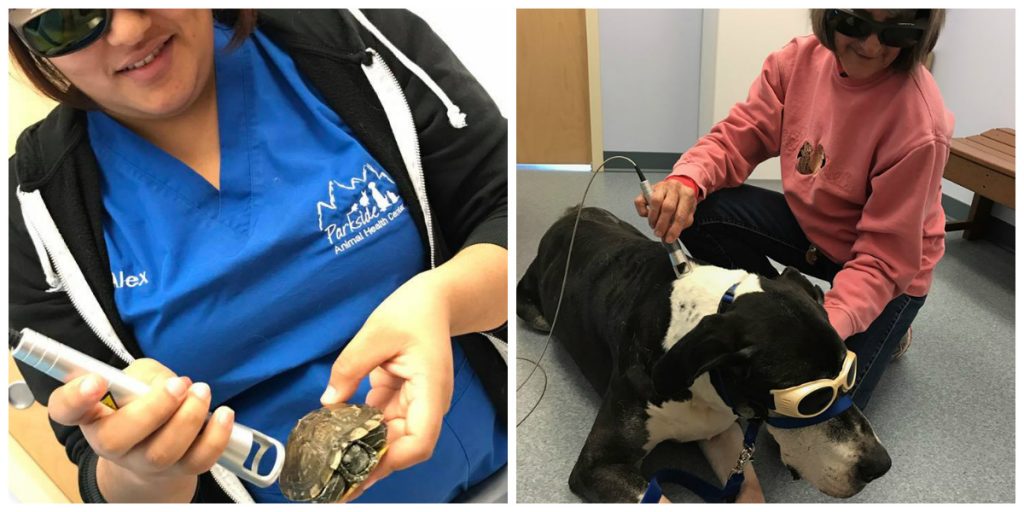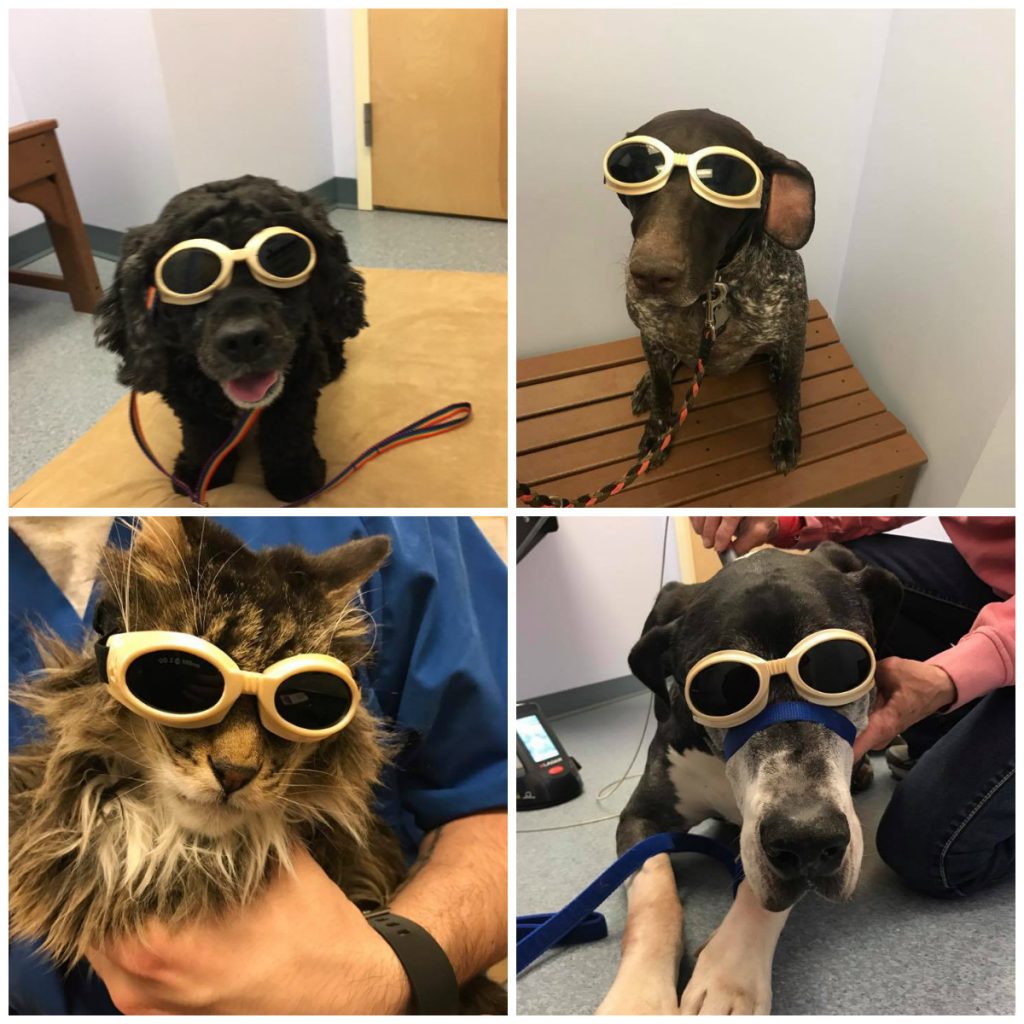Many of us think of lasers and imagine a powerful beam used to cut things with extreme precision. Or perhaps the weapon of a James Bond style evil genius. But at out Aurora vet clinic, we have a laser too! It’s called a Class IV Laser (which, interestingly, is the same class as the lasers that can split buildings!) and we use it to address pain, infection, and inflammation in our medical, surgical and wellness patients. We’ve had the laser for around a year now and so far we are very impressed with the benefits that we’ve seen.
Our laser has become an important healing aid in each of our surgeries; it has helped to decrease inflammation in chronic conditions such as ear infections, arthritis, skin conditions, bladder inflammation, and sinusitis; and it has decreased pain and infection while increasing healing speed in our pets with cuts and wounds. We’ve even used it on a red eared slider to treat shell rot! But one of the most impactful uses for our laser is in the treatment of dogs and cats suffering from arthritis.
As our pets age, similar to us, they are at an increased risk of developing arthritis. Arthritis is a progressive, painful, inflammatory process that can develop in your pet’s joints. There are different forms of arthritis but the most common is osteoarthritis. Osteoarthritis occurs when your pet’s (or your own) protective tissues, like cartilage, wear out over time. This leads to painful bone-on-bone contact, which then perpetuates inflammation and additional pain.
All of your pet’s joints can develop osteoarthritis, but the hip, knee, and spine are the most common. There is no cure for any form of arthritis, however, there are a number of treatments that can slow down disease’s progression and decrease associated pain. A Class IV laser is one of those treatments! Here’s the laser in action:
How Does A Class IV Laser Work?
What does a laser really do? Our laser has 4 different wavelengths of red and near-infrared light that can be combined as needed in specific pulse patterns to reach target tissues in the body (which helps us to treat a superficial skin infection, a strained muscle, and an inflamed bladder in three very specific ways). This is called “photobiomodulation”, where the light actually affects the metabolism within the cells and tissues to increase circulation and energy, which then draws water, oxygen and nutrients to the damaged area. This helps alleviate pain and inflammation, decreases scar tissue formation, and helps the injured area to return to normal structure and function.
Although warmth is not a primary function of the laser, the heat generated in laser therapy soothes the soft tissues around your pet’s joints and can even help them relax. The laser’s concentrated light increases the blood flow to the tissue and helps reduces inflammation. The combination of light and mild heat decreases your pet’s pain and promotes healing in the joints. Over time, this can allow them to move much more comfortably.
Laser Treatment And Awesome Goggles!
An additional benefit of laser therapy is that it’s non-invasive. Your dog will not need to be sedated, shaved, or clipped for treatments. We do not need to monitor regular bloodwork to ensure its safety for your pet, unlike many medications. However, to prevent the laser accidentally getting into your pet’s eyes, your dog or cat may need eye protection. But we see this as an extra benefit to laser treatment since it means we get to take awesome photos of our furry patients receiving their laser treatments!
Because your dog is awake during treatments, our veterinarians are able to observe your pet’s responses and can adjust treatments as needed. Most dogs find the procedures relaxing and enjoy the treatments. The treatments are between 5 and 15 minutes and there is a dose-dependent response for most medical conditions. For arthritis, most dogs and cats do best when they can have their initial 3 treatments within the first week, two during the second week, and then once weekly to every few weeks, depending on their response. By the third treatment, we expect pets to be showing a significant improvement in their comfort. Each treatment includes a short technician evaluation to allow us to track treatment progress. The overall appointment usually takes only 15-20 minutes so clients are able to fit them in pretty easily.
Because laser therapy is tailored to a specific area of the body, the most affected areas (up to 3 at a time) are addressed first, and a proper diagnosis is necessary to pinpoint these locations. For arthritis, this typically means x-rays and an examination are necessary prior to beginning therapy – this not only sets your pet up for success but also helps to rule out other causes for pain that may not be appropriate for laser therapy (cancers of the bone and cartilage).
There are other treatments available that can help with arthritis and inflammation, but many have unwanted side effects. The most common medication for arthritis treatment are non-steroidal anti-inflammatory drugs, but prolonged use can cause gastrointestinal, kidney, and liver side effects. In addition, cats cannot tolerate these drugs well over a long-term treatment (their liver lacks the enzymes to appropriately break them down, and their kidneys are very sensitive to their side-effects). Laser therapy doesn’t cause any of these problems. As a result, it can be the perfect option for cats, as well as dogs that may already have kidney or liver issues. The laser can also be used in conjunction with non-steroidal anti-inflammatory drugs, supplements, and prescription joint diets to help create a more holistic treatment plan.
More Than Joint Discomfort: Using Laser Therapy For A Wide Range Of Conditions
At Parkside Animal Health Center, some of the most common conditions, besides arthritis, that we use the laser for is in surgery and dentistry. There are only a few places where we cannot use laser therapy safely, including directed into the eyes, over the thyroid gland, over a pregnant uterus, over tattooed skin (spay tattoos, for example), and over cancer. Therefore, nearly all of our surgical incisions (except for mass removals, and these besides the eye or thyroid gland) are perfect for the benefits of laser therapy. In addition, we laser the gum tissue throughout the mouth after every dental procedure. This not only decreases the inflammation present in the mouth and improves healing after dental extractions, but also helps to minimize the risk of infection from the oral bacteria released during tartar and plaque removal.

Our Aurora Veterinary Clinic Is On The Cutting Edge!
Low-level laser therapy is a relatively fast, non-invasive, pain-free treatment that can provide help with tissue healing and pain relief to help get your pet moving again and improve their quality of life. It’s also one of the many ways that Parkside continues to stay on the cutting edge of veterinary medicine (pun intended).


